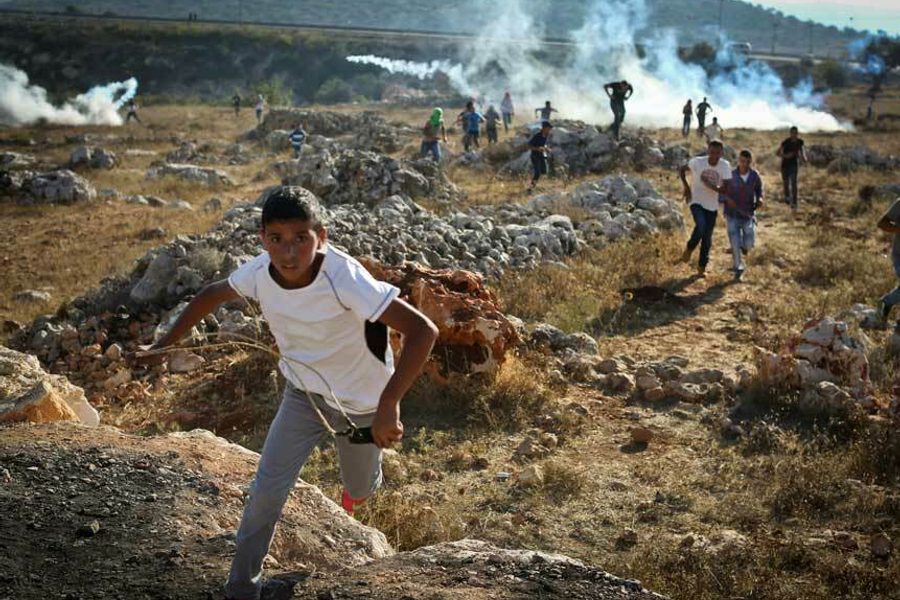In the West Bank, the Kids Aren’t All Right
Palestinian children are taken from their beds in night raids and not returned to their families for months.
Beth Maschinot

Israeli military strategists and pundits call it “mowing the lawn”: the periodic bombardment of Gaza, like last summer’s Operation Protective Edge. Critics of Israeli policy point out that this metaphor is callous but apt: There will be no targeted weeding; instead, wide swathes of “grass” will be cut. The action must be repeated at certain intervals, lest the lawn get out of control. The metaphor also intimates that the cost to Israel is minimal: Perhaps the landowner works up a mild sweat, but if the blades are kept sharp and the motor running smoothly, the job will not exact much of a toll.
But lawn-mowing is not an option in the West Bank, in part because the Palestinian Authority has nominal control over some areas, but also because the presence of more than 350,000 Israeli settlers rules out a full-scale military siege. Instead, the reigning strategy appears to be mass intimidation and collective punishment of the Palestinian population, most visibly when Israel can offer a rationale. For example, in June 2014, Israel announced the official goals of Operation Brother’s Keeper: To find three kidnapped teenage settlers and then root out the parties responsible. That month, Israeli forces launched a wide sweep of the West Bank, arresting 400 Palestinians and raiding more than 1,000 homes, according to a report from the British Foreign and Commonwealth. At least six Palestinians (including two children) were killed.
While Israel’s actions last summer were highly visible, Gerard Horton of Military Court Watch (MCW), a group that monitors Israeli detention of Palestinian children, says this strategy of mass intimidation and collective punishment operates in a less publicized way on a daily basis in the West Bank. And Palestinian children are often the targets.
Each year, 500 to 700 minors, almost all boys, are arrested and detained in Israeli military prisons, according to the human rights organization Defence for Children International. Most are charged with the offense of throwing stones, typically at settler’s cars or at Israeli Defense Force’s (IDF) military vehicles during demonstrations. Horton says that one boy was charged with throwing stones at the Separation Wall, which has been deemed a military installation. While only children 12 and older bear criminal liability under Israeli law, there is documentation that the IDF has picked up much younger children. A video posted by Israeli human rights group B’Tselem shows the growing hysteria of a 5-yearold boy who was picked up in July 2013 for throwing stones at a settler’s car. He was brought home, then taken with his father to an IDF base and later transferred to a Palestinian police station, where he was questioned and released. After the incident made international headlines, IDF Central Command opened an investigation into the incident. However, the IDF’s legal adviser later concluded that soldiers have the authority to detain children under 12, the age of legal responsibility, if they “endanger public safety.”
Israel is the only country in the world that has instituted a juvenile military court, which it bills as a humane alternative to trying juveniles in adult military court. But reports by UNICEF, Defence for Children and the British government find serious, ongoing violations related to the treatment of children in the military detention system. A 2013 UNICEF report noted longstanding allegations that Israel practices “cruel, inhuman and degrading treatment” of Palestinian children in its detention system and concluded that this ill treatment appeared to be “widespread, systematic and institutionalized.” A 2012 report by a delegation supported by the British Foreign Office concluded that Israel’s treatment of juvenile detainees runs counter to several international laws. This delegation, which included the former attorney general of Britain, speculated that this treatment probably “stems from a belief, which was advanced to us by [an Israeli] military prosecutor, that every Palestinian child is a ‘potential terrorist.’ ”
Friction points
Horton, an Australian ex-pat and a human rights lawyer, co-founded MCW to advocate for the rights of children caught up in the Israeli military detention system. Horton, however, is careful not to vilify Israel. “The Israelis are not unique in this regard,” says Horton. “Human rights tend to go out the window after six months of any military occupation. And this occupation has lasted 47 years — Israel has just had time to perfect it.” Horton adds that Israel’s detention policies have been “successful” — if the goal is to pacify entire Palestinian communities.
What is particular to the situation in Israel, though, is the presence of settlers in the West Bank: occupiers living among the occupied. According to B’Tselem, Israeli settlements have claimed 42 percent of land in the West Bank. This tally includes land taken up by the ubiquitous military bases that are built alongside the houses, shops and farmland of the settlement proper. Many of these settlements were built on the olive groves, houses, farmland, and shops of Palestinians. All are designated closed military areas, and are off-limits to all Palestinians without a permit.
Meanwhile, the settlers are allowed to travel freely in many areas heavily populated by Palestinians, sometimes surrounded by a cluster of IDF soldiers in what seems to amount to a military escort. According to international law, Israel, as the occupying power in the West Bank, is also legally mandated to protect Palestinians from settlers. But for decades, settlers have burned down Palestinian farms, chopped down olive trees, poisoned wells, killed livestock and beaten Palestinian villagers with impunity. Between 2005 and 2011, the Israeli human rights group Yesh Din monitored 781 investigations conducted by Israeli police into incidents of settler violence, finding that just 10 percent resulted in indictments. And most incidences are believed to go unreported, given this record and the fear of reprisal from settlers.
This mix of Zionist settlers, Palestinians and IDF soldiers is volatile. According to Horton, Palestinian children living near these “friction points” are particularly vulnerable to arrest.
Horton and his MCW co-founder, Salwa Duaibis, were recently in Chicago to speak to a U.S. public that hears next to nothing from the mainstream media about the daily brutality of life under occupation. While here, they helped kick off the No Way to Treat a Child Campaign, sponsored by Jewish Voice for Peace, the American Friends Service Committee, the Friends of Sabeel, and other U.S. groups working for Palestinian self-determination. The short-term goal of No Way to Treat a Child is to raise U.S. awareness of the abuses and human rights violations that accompany child detention, and exert pressure on Israel to put a stop to them; the long-term goal is an end to the occupation that creates these abuses.
Some organizations, like the ecumenical group Friends of Sabeel North America (FOSNA), seek to create additional pressure on Israel by joining groups in the U.S. and EU that call for a boycott of Group 4 Securicor (G4S), a multinational security company based in Britain. G4S provides security systems to military checkpoints and to Israeli military prisons, including the Al-Jalame detention facility where child detainees are frequently interrogated.
Night terrors
Speaking to U.S. audiences, Horton describes in stark detail how the Israeli strategy works. Horton narrates the story from the perspective of an IDF junior commander: “You get a call saying that a group of young boys or teens are seen throwing rocks at settler’s cars on the road. If you let this go unpunished, these acts will proliferate and the Israeli settlers will take matters into their own hands. You’ll lose control of that section of the road and you’ll be replaced. So what do you do if you can’t identify the stone-throwers?”
In this most common of situations, you lean on Palestinian informants — a number that grows larger as Palestinians become more desperate under the occupation and can be more easily threatened or bribed. Or you round up boys fitting a general description, or who have been seen at local demonstrations. Another tactic is to target youth whose names other child detainees have “given up” under harsh interrogation techniques. In all of these scenarios, some of the boys named have thrown stones, and some have not. Individual culpability seems to be beside the point.
Horton then describes a typical arrest scene. “If you, the IDF commander, don’t want a riot, you go in at night. There’s less opportunity for casualties. It also terrifies everyone in the community. So you go in at 2 a.m. with scores of soldiers. You are in full battle gear, with camouflage on your face. You bang on the door, and if it’s not opened quickly, it will be blasted off its hinges. Or you come in quietly, take the front doors off the hinges, and enter the bedroom. The child then wakes up with five soldiers pointing their guns at him.”
The nightmare continues, terrorizing all in the house. Brothers and sisters scream as soldiers stand over their brother, guns pointed. Mothers and fathers wake up to the sound of their children’s distress and try desperately to stop the soldiers, then follow them out of the house, begging for information on where their son is being taken. That information is rarely given. These images stay with the child, says Duaibis, who is also the head of the international advocacy unit at the Ramallah based Women’s Center for Legal Aid and Counselling: “The last thing the child saw before he was put in the back of a jeep was his father being pushed around, humiliated by a soldier, shouted at, kicked with a gun. It shatters his sense of safety when he finally returns to his house. … He often begins to disrespect his father because his father was helpless in front of the IDF.”
The parents also feel like failures. They couldn’t do anything to protect their child. Duaibis describes the sense of futility that mothers often feel, especially mothers of children who did nothing to provoke the arrest: After years of admonishing their sons to stay away from the IDF, from settlers and from stone throwing, they realize nothing they do can protect their child.
The impact on children who are innocent of any wrongdoing can be “mindboggling,” says Duaibis: “Like all children, they are brought up to figure out consequences in life. They’re told if you don’t throw stones, you will be safe. This shatters their understanding of what life is all about.”
An effective strategy
The raid is only the beginning of the child’s pain and humiliation. His hands are bound with plastic ties — the kind that bind tighter and cut off circulation if you struggle. He’s blindfolded and shoved in a military vehicle, sometimes placed on the metal floor for the trip on a rocky road to an interrogation. Boys report soldiers taunting them during the ride and calling their mothers and sisters “whores.”
At the interrogation center, many children are shackled or tightly chained to a chair while interrogated. According to the UNICEF report, which reviewed more than 400 cases of children detained by Israel since 2009, not one of these children was accompanied by a lawyer or family member during the interrogation, a violation of the UN Convention on the Rights of the Child. Since there is no independent third party present, and the interrogations are not videotaped, coercion is rampant. (The Israeli government enacted Military Order 1745 this past September, which calls for the audio-visual recording of police interrogation of minors. However, this order does not cover children accused of “security offenses” such as throwing stones, so it is unlikely to improve the situation of most child detainees.)
UNICEF reports that interrogations are carried out with “the clear purpose of forcing the child to confess.” Children report having been threatened with death, beatings, solitary confinement and sexual assault. Most children confess under this duress. Many sign a confession in Hebrew, a language the majority of Palestinian children don’t understand.
If the child does not confess, it’s his word against the interrogators’ when he stands before the judge. The child’s chances are slim: The conviction rate inIsrael’s military courts is 99.74 percent, according to court records obtained by Haaretz in 2011. Defence for Children reported in 2013 that about half of convicted children were being held in prisons inside Israel — a violation of Article 76 of the Geneva Convention, which states that if occupying powers establish military prisons, they must be in the occupied territory. Given the difficulty of obtaining travel permits, families often can’t visit their children in prison.
According to Horton, children who are found guilty are usually released after spending two to three months in prison. Many are also given a suspended sentence that varies from six months to two years, during which the child can be sent back to prison if he is picked up by the IDF again.
These traumatic experiences exact a toll on the child: Most show classic symptoms of PTSD, including being on high alert, suffering from insomnia, and when sleep finally comes, waking up screaming from night terrors. They lose their appetites, withdraw from friends and even refuse to play with siblings. Many detainees, especially those who are incarcerated for more than a few days, drop out of school. Most disturbingly, they are shadowed by a deep sense of futility about the future.
The physiological trauma and the threat of further sentencing induce passivity. Rather than angry young men out to retaliate, Horton describes boys released from detention as broken and defeated. They strenuously avoid the IDF at all costs. “From the perspective of the military,” says Horton, “this is a great way to control young people. In each generation, you identify those 10 to 15 percent of boys with a bit of spark and you put them through the system. Most will come out with trauma and you’ll never have any problems with those individuals again.”
And for parents, the dread that the IDF will come and take their child in the night weighs heavily. Duaibis sees signs of this when she visits the villages: mothers sleep-deprived from keeping watch out their windows until sunrise, wanting to be able to “wake their children gently” should the IDF show up. Close-knit communities pulled apart by suspicion, terrified to organize against the occupation. The boys formerly “with spark” are now the most defeated of all. All of this has worked to Israel’s advantage for decades, grinding down the population. Says Duaibis, “If you are in the business of occupying people and on top of that you’ve moved your own civilian population onto those people’s land, this is the only way to do it — one child at a time, one family at a time, day in, day out, non-stop. Because if you blink they are going to do everything it takes to drive you out. … And is it surprising that they would want to drive you out? I think we should all ask ourselves the question: What would we do if our land was taken from us and given to other people to settle and flourish and live a normal life, while we suffer?”
But alongside the fear and demoralization, there is also massive resentment burning below the surface, exploding in attacks (like the November 2014 killing of five people, including three rabbis, at a synagogue in Jerusalem) that are shocking and predictable all at once.
Meanwhile, Israel ups the ante. In the wake of the killings at a kosher supermarket in Paris, Netanyahu called for more French Jews to immigrate to Israel. On January 12, Israeli Housing and Construction Minister Uri Ariel dispatched a letter to the settlement council about the possibility of expanding settlements to accommodate a new wave of French Jewish immigrants.






